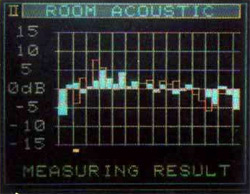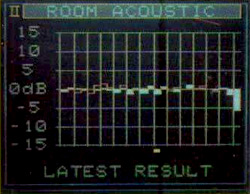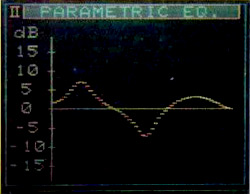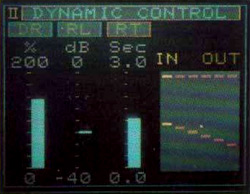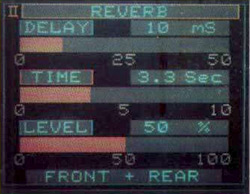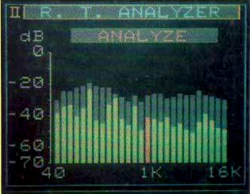Marantz AX1000 audio computer
As an audiophile, you're undoubtedly aware that no matter how accurate each component is in your audio system the listening room in which it's located will place its own sonic 'fingerprint' on the overall sound. And because the room is most often considered prime living spacem its sonic character may vary widely over time. Also, when purchasing new audio components -especially loudspeakers- it's impossible to predict beforehand how they will sound in your particular listening room.
Now, with the Marantz AX-1000 Audio Computer, eliminating acoustic anomalies and enhancing the sound of your listening room can be performed easily and with the same accuracy of the finest digital studio equipment.
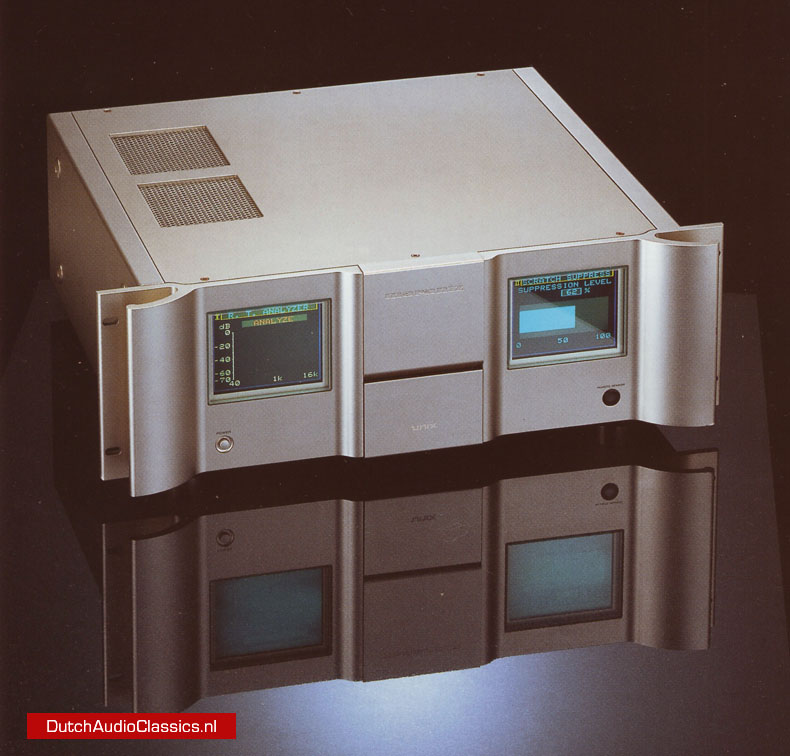
The Marantz AX-1000 is a high-speed microprocessor-based computer that performs sophisticated signal processing totally in the digital domain. Its four main areas of audio processing include frequency response control, ambience control, audio signal conditioning and testing and measurement facilities. The AX-1000 uses digital signal processing (DSP) for all its functions, thus eliminating all analog processing imperfections such as noise and phase problems.
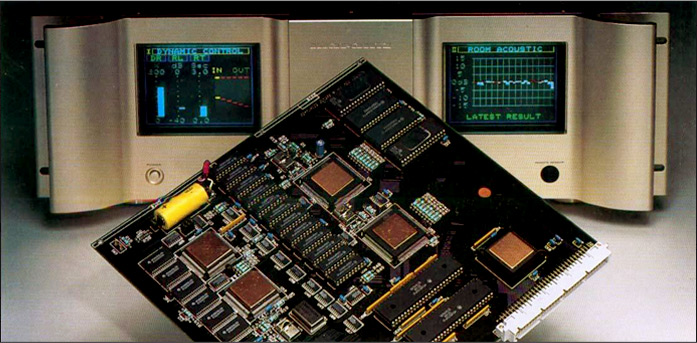
The AX-1000's main circuit board consists of two independent DSP processors, two video display drivers, and a 16-bit microprocessor.
The Marantz AX-1000 is equipped with two 4-inch front-panel color LCD screens that show all pertinent operating information. In addition, the displays can ben used to show system frequency response via the system's real-time analyzer, plus other graphic modes to support the test-based menu functions. The AX-1000 operates entirely from its remote control, which features a track-ball system similar to those found on computers. Video outputs are provided for each LCD screen, allowing the use of external video monitors or computer displays.
The AX-1000 is designed with all circuit systems located on separate, plug-in cards. This design provides maximum flexibility for future upgrades and gives the user the freedom to custom configure the system to his needs. Marantz uses this 'sequential development' circuit design so that AX-1000 owners can keep with improvements in DSP technology.
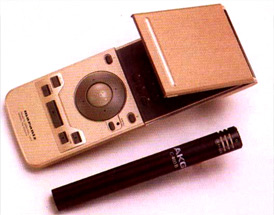
Easy interactive operation of the AX-1000 is achieved via the track-ball remote control. A calibrated AKG C-460B studio mic is supplied for use duriing automatic room equalization
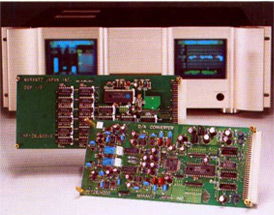
The AX-1000's digital processing system is driven by a 1-bit, 64-times oversampling A/D converter, and a 20-bit digital filter, 128-times oversampling bit-stream D/A converter with 3rd-order noise shaping.
Frequency repsonse control
The AX-1000 can automatically correct the acoustic anomalies associated with your listening room. It does so by recording test tones through the supplied AKG C-460B microphone which is positioned at the normal listening position. The computer then calculates a series of 14 digital filters per channel to achieve the desired acoustic response for the room. These digital filter algorithms are then stored in RAM and can be recalled at any tiem. Additional measurements can ben made at any time to account for changes in the room or the audio system.
The target curve for the room van ben set over the entire frequency band (40Hz to 16kHz) or adjusted for only a particular bandwidth as set by the user. The resulting shape of the curve need not be flat, but can be fully adjusted to achieve the desired result. Further adjustment is provided via 3-band digital parametric equalization, allowing user control of frequency range, gain and frequency bandwith ('Q').
Ambience control
The AX-1000 provides for sophisticated ambience processing, performed completely in the digital domain. For example, digital reverberation is provided to enhance 'dry' prerecorded material or to add 'space' to user-made recordings. Complete control over delay time (0-50ms), decay time (0-10 secs.) and reverb amount (0-100%) is provided.
Concert Hall recreation is possible with the AX-1000 with presets available based on acoustic measurements of the following concert halls: Symphony Hall, Boston, Vienna Grosser, Musikvereinsaal, Palais Des Beaux Arts, Brussels, Leipzig Neues Gewandhaus, Royal Albert Hall, London, Concertgebouw, Amsterdam, Metropolitan, Opera House, New York, and Bayreuth Festspielhaus.
Fully digital decording of movie soundtracks is alos perfomed by the AX-1000. Most consumer surround decorders rely upon analog matrix decoding and analog noise reduction, even if the delay claims to be digital. The AX-1000 does all of its processing --high separation 2- to 4-channel matrix decoding, and time delay for the surround channel-- in the digital domain. It also uses full 16-bit bandwidth resolution that does not limit the dynamic range of the original program material, and can decode both digital and analog surround sound material.
With its Stereo Control, the AX-1000 can reduce or expand the stereo soundstage of any audio recording. Adjustment over 11 preset steps is provided, covering the range from mono to expanded stereo. Finally, the AX-1000 provides a special headphone processing system that digitally places the soundstage in front of the listener instead of somewhere inside the listener instead of somewhere inside the listener's head. Dedicated headphone processing is provided for the following models: AKG K-240, Jecklin Electrostatic Float, Sennheis Hd-540 and Stex Lambda Pro Series.
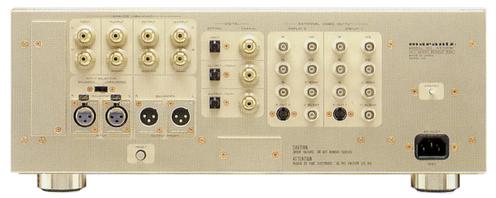
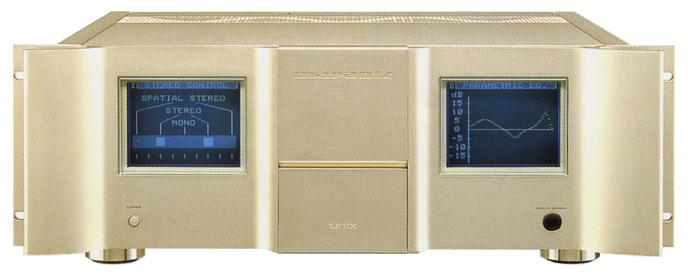
Signal conditioning
The Marantz AX-1000 includes a dynamic range control system, that can increase or decrease the dynamic range of the audio program. For example, a user might increase the dynamic range of analog recordings and broadcasts, while decreasing that of very wide dynamic range digital source material. Users can select and set compression and expansion characteristics, and adjust them to fine degree. Control over dynamic range (10-190%), reference level (-40dB - 0 dB) and release time (0.10-3.0 secs.) is provided.
Digital scratch noise suppression is performed by the AX-1000 by digitizing the incoming analog signals from a phono preamplifier. When the scratch detector's algorithm senses the abrupt change in the signal caused by a scratch, it mutes the delayed signal level to a degree indistinguishable by the human ear. The system is accurate to within 4 to 5 digital samples, and the sensitivity of the AX-1000 controls the timelength of the muting. Scratch suppression level is user adjustable, and
the processed signal can ben used to digitally output a clean signal for archiving to DAT, DCC or CD-R.
Measure facilities
The Marantz AX-1000 provides a full palette of sophisticated measuring facilities. Included are a sine generator that delivers digitally synthesized sine waves for any frequency from 20Hz to 20 kHz, with adjustable level from 0 dB to -80 dB; a white noise generator that provides white noise over a range of 0 dB to -80 dB; and a pink noise generator for pink noise from 0 dB to -80 dB. The AX-1000's Real-Time Analyzer functions as a 27-band real-time analyzer at frequencies from 40 Hz to 16 kHz. A defeatable peakhold function is included.
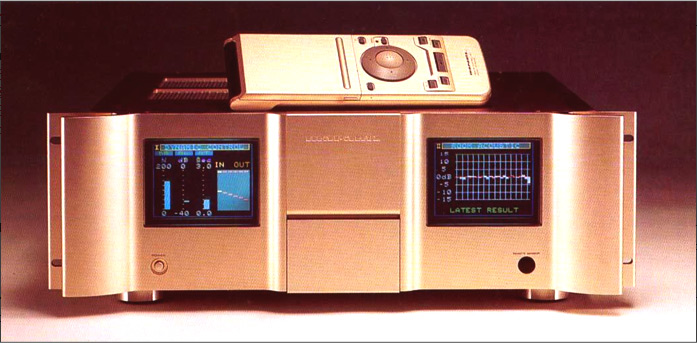
Specifications
| Analog input sensitivity: | 500mV |
| Analog input impedance: | 10 k-ohms |
| Analog output level: | 2 volts |
| Analog output impedance: | 50 ohms |
A/D converter |
|
| Total harmonic distortion (0dB/1kHz): | 0.003% |
| Signal-to-noise ratio: | 90dB |
| Frequency response: | 15Hz to 20kHz |
D/A converter |
|
| Total harmonic distortion (0dB/1kHz): | 0.003% |
| Signal-to-noise ratio: | 100dB |
| Frequency response: | 15Hz to 20kHz |
| Channel separation: | 100 dB/ 1kHz |
Digital Input Level |
|
| Coaxial: | 0.5 volts p-p |
| Optical: | -19 dBm to -21 dBm |
Digital Output Level |
|
| Coaxial: | 0.5 volts p-p |
